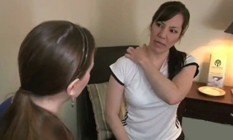There’s that nagging pull in your shoulder, just calling out to you “Just one crack. I’m begging you.” And snap. Ahhhh. You’ve cracked your neck, feel the temporary relief, and hear that satisfying sound of your neck popping back into place. Let’s take a step back and look at what’s really happens and learn safer ways to care for your neck and remain on the pain-less side of life, not just temporarily but for the long haul. After all, you’ll be needing that neck for years to come.
With chronic strain, postural imbalance, or instant trauma comes an imbalance in cervical joint mobility. As one joint stiffens, the others around it take on more of the job required to rotate and flex your neck. What happens when tension mounts and you succumb to the urge to pop your neck is you’re actually encouraging increased mobility in these hyper-mobile joints and doing nothing for the joint that’s seizing. The more you practice this habit the more you add to the problem.
Why not practice these habits instead. I challenge you to try these tips for a week or two and see how you feel. It’s likely your body will be less apt to signal the urge to self adjust and that’s a smarter way to take care of YOU!
1.If you have the urge to self adjust the left side of your neck, spend more time gently stretching the right side of your neck. How stretching the opposite side helps follows the principal of Passive Positional Release. Gentle stretching should be frequent (hourly). Visit these links to learn safe ways to stretch your neck: Exercises To Stretch Your Neck.
2. After a few days of #1, apply these same movements but add in these Contract-Relax technique. Ask your massage therapist or physical therapist to demonstrate contract relax. These are gentle techniques often applied during massage and they help to unwind a muscle memory that is signaling the muscle to remain tight. It is essential that you learn proper technique and prevent an injury from performing the action.
3. Hang from a bar or the top of a door molding (take care and be sure it’s secure). This allows you to stretch the muscles in your armpit and loosens the pull on the top of your shoulders and neck. Drop your weight into your legs gradually, to the point where you feel gentle resistance. Loosening your shoulders is KEY to busting the urge.
4. Stretch your chest muscles. Lean into a doorway. Gently, waiting for the resistance to ease. Breathe when stretching. Don’t force but rather return frequently to the stretch throughout the day.
5. Pay attention. The urge to crack is a signal. Use it as your reminder to get back to taking care of you.
6. Visiting your massage therapist weekly during these first few weeks. Massage therapy will assist with softening the tissues you are aiming to release and add to the success of your program.
If these tips don’t help, visit a sports medicine doctor (such as an orthopedist who does not perform surgery), chiropractor, or physical therapist for an evaluation. Find out what condition your neck is in so that you and your care provider can develop a targeted treatment plan. Necks do heal but the longer you allow an injury to go untreated the deeper the damage and the more difficult to heal and put on the correct path again. Now is a good time to take care of the problem and prevent permanent injury to your disc cushions, facet joints, and ligaments.
= = = = =
Hands On Health Massage Therapy And Wellness
7980 Chapel Hill Road, Ste 125
Cary NC 27513
919.854.9555

